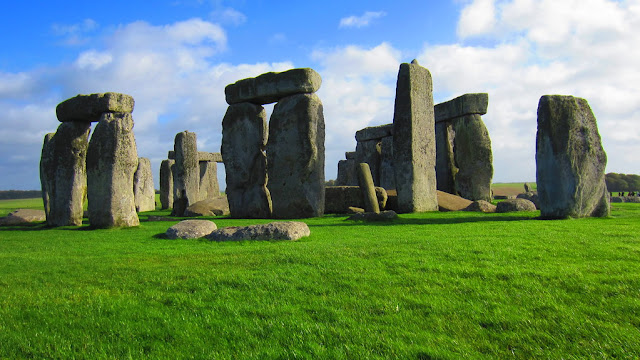THE STONEHENGE SITE, AN ENIGMA FOR HISTORY
Stonehenge is England’s main prehistoric sanctuary and one of the most disturbing in the world. A fabled place that remains among the essential visits to make with our English neighbors.
 |
| [This picture is collected from Pixabay By TheDigitalArtist which is licensed under Public Domain Certification] |
STONEHENGE, PREHISTORIC SANCTUARY
Leaving London to arrive in Wiltshire County, in the significant heart of Great Britain, the road through the Salisbury Plain is a bit monotonous. The emotion is all the subordinate when we ultimately discover on the right the ghostly contour of the monuments of Stonehenge. Everyone has in mind the image of this mysterious circle of giant tombstones erect towards the sky, classified as a World Heritage Site by UNESCO. It's insoluble not to be impressed by the discovery of this mysterious sanctuary.
A PRESERVED ENCLOSURE
The locale is part of the heritage managed by the English Heritage. It's one of the busiest in England and arrangements have been made to manage the binge of the numerous visitors. A Visitor Center has been set up at the entrance to the venue, 2 km from the standing tombstones. You can visit the gallery which brings together 200 archaeological remains and constitutional with children in the small reconstructed huts of a Neolithic vill. You can enter the tombstone circle on base or in a shuttle. The locale is defended by a barricade forming a large circle around the monument.
 |
| [This picture is collected from Flickr By Momentum Dash which is licensed under CCO 1.0] |
WHO, WHEN, HOW, WHY?
Sanctuary of a solar cult, astronomical outlook, funerary monument. Who, when, how and why did men, so long ago, go to great lengths to erect this monumental tombstone circle? The enigma remains about Stonehenge. The word Saxon means" stone gibbet" or "hanging stone" which evokes the construction assembled in pillars and lintels. The subject fascinates archaeologists, astronomers and guests. The spot was used for a long time by the Celtic druids for their rituals. But the heavy standing monuments were there long before they arrived. They were erected by ancient indigenous populations. And not, as chroniclers have long reflection, by the Mycenaean.
THE REALM OF THE DEAD
A first external quadrangle 90 rhythms in circumference was raised around 3000 whiles before our time. It's bounded by a small levee lined with a trench. The entrance to the sacred circle was indicated by two headstones. A third tombstone, Hell Stone, was placed outside the quadrangle. There were still four batches of sandstone, Station Saracens, to tag the four cardinal junctures. 56 holes dug in the inner side of the anomaly revealed multiplex natural bones. The venue was probably used as a cremation center and burial venue for centuries.
 |
| [This picture is collected from Wikimedia Commons By Frédéric Vincent which is licensed under CC BY-SA 2.0] |
A CIRCLE OF BLUE MONUMENTS
Around spells before our period, the spot was transmuted by the construction of an inner circle made up of 80 uncut blue monuments, the blues monuments. These monuments come from Preseli Hills, fresh than 200 km in South West Wales! They were probably transferred by water through the Bristol Channel. Five hundred spells thereafter, this structure is dismounted and assembled to form an inner circle. It's girdled by a first strand monument circle probably from Marlborough Downs, 30 km north of the spot.
MENHIRS IN BALANCE
Moment, a certain number of gravestones have collapsed or have dematerialized, but one can still appreciate a set of standing gravestones formed by two upright supports added than 4m high on which rests a lintel clenched by tenons and mortises. A specialized feat when you allow that wheeled wagons didn't be when construction started. These gravestones are believed to have been pulled from sleds by hundreds of men. They were lifted and set up using tree bins, dials and scaffolding made of clumsy logs.
 |
| [This picture is collected from Flickr By Nelo Hotsuma which is licensed under CC BY 2.0] |
AN ASTRONOMICAL OUTLOOK
Multiple more or less eccentric suppositions have been developed about Stonehenge standing monuments. Could it be an astronomical outlook or a sanctuary earmarked to the idolatry of the sun? Possibly a orthodox place where the change of seasons was celebrated? What's certain is that on the day of the summer solstice, if we look towards the sun from the central monument, it rises exactly above the magic monument of the Talon, Hell Stone, placed at the entrance 800 m out. Other mileposts feel to coincide with the equinoxes and the cycle of lunar degringolades. And yet, the so- called primitive populations who erected the monuments probably didn't have the scientific knowledge to engender such an outlook. Stonehenge still hasn't disclosed all of its enigmas!
TRAVEL GUIDE
Stonehenge, Wiltshire SP4 7DE. Access via the M3 motorway either A 303 or A 360 to Airman’s Corner. The locus is located 16 km north of Salisbury. Day passages by car are organized from London to explore the Stonehenge locus. For else information, visit these: http//www.visitwiltshire.co.uk | www.english-heritage.org.uk | http//www.visitbritain.com


0 Comments